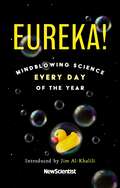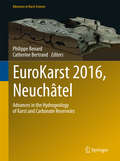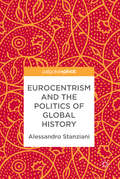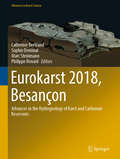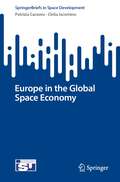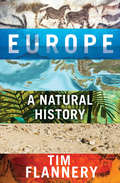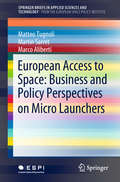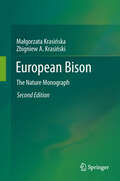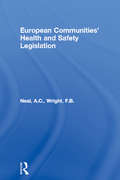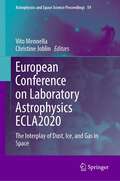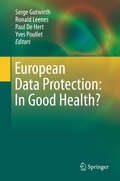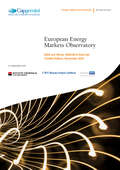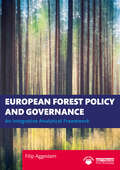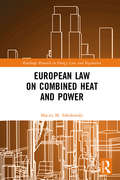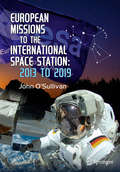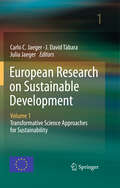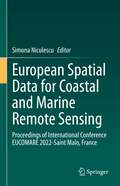- Table View
- List View
Eureka! It's an Airplane!
by Jeanne BendickUncovers the chain of discoveries--dating back to the ancient Greeks and including the contributions of the Wright brothers--that led to the invention of the modern airplane.
Eureka!: 50 Scientists Who Shaped Human History
by John GrantGalileo, Einstein, Curie, Darwin, Hawking — we know the names, but how much do we really know about these people? Galileo gained notoriety from his battle with the Vatican over the question of heliocentrism, but did you know that he was also an accomplished lute player? And Darwin of course discovered the principle by which new species are formed, but his bold curiosity extended to the dinner table as well. (And how many people can say they've eaten an owl!) In Eureka! John Grant — author of Debunk It!, Discarded Science, Spooky Science and many others — offers fifty vivid portraits of groundbreaking scientists, focusing not just on the ideas and breakthroughs that made them so important but also on their lives and their various...quirks.
Eureka!: Mindblowing Science Every Day of the Year
by New ScientistIntroduced by Jim Al-KhaliliCould you surf down an erupting volcano?Why do zebras have stripes?Are you breathing the same air as Leonardo da Vinci?Are there any green mammals?Why do pineapples have spikes?Why do songs get stuck in your head?What happens when black holes collide?Can you extract your DNA?New Scientist has been a treasure trove of fascinating and surprising questions and answers for over a decade. From how to measure the speed of light using chocolate, to why dogs howl at sirens, Eureka! brings together 365 mindblowing questions, fascinating facts and exciting experiments.If you've ever wondered how to escape quicksand, what would happen if the moon vanished, and why cats (nearly) always land on their feet, you've come to the right place.
Eureka!: Mindblowing Science Every Day of the Year
by New ScientistIntroduced by Jim Al-KhaliliCould you surf down an erupting volcano?Why do zebras have stripes?Are you breathing the same air as Leonardo da Vinci?Are there any green mammals?Why do pineapples have spikes?Why do songs get stuck in your head?What happens when black holes collide?Can you extract your DNA?New Scientist has been a treasure trove of fascinating and surprising questions and answers for over a decade. From how to measure the speed of light using chocolate, to why dogs howl at sirens, Eureka! brings together 365 mindblowing questions, fascinating facts and exciting experiments.If you've ever wondered how to escape quicksand, what would happen if the moon vanished, and why cats (nearly) always land on their feet, you've come to the right place.
Eureka!: Science's Greatest Thinkers and Their Key Breakthroughs
by Hazel MuirFrom Aristotle's pioneering research into animal biology to Harvey's theory of the circulation of the blood; from Copernicus's theory of the heliocentric universe to Carl Sagan's speculations on extraterrestrial life; and from Einstein's theory of Relativity to Heisenberg's uncertainty principle, Eureka! condenses the essential biographies and principal discoveries of the world's most important scientistsinto 300 bite-sized entries. Spanning the full spectrum of scientific disciplines - including physics, biology, earth science, cosmology, chemistry, archaeology and behavioural science - this book is the perfect introduction to the pioneering work of scientists throughout the ages.
Eureka: Discovering Your Inner Scientist
by Chad OrzelEven in the twenty-first century the popular image of a scientist is a reclusive genius in a lab coat, mixing formulas or working out equations inaccessible to all but the initiated few. The idea that scientists are somehow smarter than the rest of us is a common, yet dangerous, misconception, getting us off the hook for not knowing#151;or caring#151;how the world works. How did science become so divorced from our everyday experience? Is scientific understanding so far out of reach for the non-scientists among us? As science popularizer Chad Orzel argues in Eureka, even the people who are most forthright about hating science are doing science, often without even knowing it. Orzel shows that science isn’t something alien and inscrutable beyond the capabilities of ordinary people, it’s central to the human experience. Every human can think like a scientist, and regularly does so in the course of everyday activities. The disconnect between this reality and most people’s perception is mostly due to the common misconception that science is a body of (boring, abstract, often mathematical) facts. In truth, science is best thought of as a process: Looking at the world, Thinking about what makes it work, Testing your mental model by comparing it to reality, and Telling others about your results. The facts that we too often think of as the whole of science are merely the product of this scientific process. Eureka shows that this process is one we all regularly use, and something that everybody can do. By revealing the connection between the everyday activities that people do#151;solving crossword puzzles, playing sports, or even watching mystery shows on television#151;and the processes used to make great scientific discoveries, Orzel shows that if we recognize the process of doing science as something familiar, we will be better able to appreciate scientific discoveries, and use scientific facts and thinking to help address the problems that affect us all.
EuroKarst 2016, Neuchâtel
by Catherine Bertrand Philippe RenardThis book presents the latest advances in the field of karst hydrogeology and carbonate reservoirs. These include, but are not limited to: geomorphology of karst, flow and solute transport in karst; innovative metrology; modelling; speleogenesis and geology of carbonate reservoirs; deep reservoir exploration and production; water management and protection in karst environments; contaminant migration and chemical behavior; hydrochemistry and regional aquifer studies. EuroKarst offers a platform for professional exchanges between field practitioners and academic researchers. It is the European biennial conference on the hydrogeology of karst and carbonate reservoirs. It is organized every two years by the Universities of Neuchâtel (Switzerland), Besançon (France), and Malaga (Spain).
Eurocentrism and the Politics of Global History
by Alessandro StanzianiGlobal history locates national histories in the context of broader processes, in which the West is not necessarily synonymous with progress. And yet it often suffers from the same Eurocentrism that plagues national history, accepting Western categories and values uncritically and largely ignoring non-English historiographies. Alessandro Stanziani examines these tensions and asks what global history is and ought to be. Drawing upon a wide array of sources, he historicizes global history writing from the sixteenth century onward, tracing the forces of revolution, globalization, totalitarianism, colonization, decolonization and the Cold War. By considering global history in the context of a longue durée, multipolar perspective, this book assesses the strengths and limits of the field, and clarifies what is at stake.
Eurokarst 2018, Besançon: Advances in the Hydrogeology of Karst and Carbonate Reservoirs (Advances in Karst Science)
by Catherine Bertrand Philippe Renard Sophie Denimal Marc SteinmannThis book presents selected papers from the EuroKarst 2018 conference, which highlighted the latest advances in the field of Karst Hydrogeology and Carbonate Reservoirs. The event attracted more than 180 participants. From among their contributions, the papers were selected and subsequently reviewed by the scientific committee to ensure the highest possible quality.
Europe in the Global Space Economy (SpringerBriefs in Space Development)
by Clelia Iacomino Patrizia CaraveoThis book analyzes the policies and space economy programs of major space-faring nations and explores whether the present institutional set-up in Europe is adequate to address the challenges. At the core of the discussion are the relative roles of governments and markets in a highly dynamic panorama that involves advancements in science, modifications in technology and organization, and the introduction of new rules of behavior. After a close examination of the history of development of the space economy, and the shift from the centralized model to deregulation and the opening up of space activities to commercial companies, a wide-ranging overview of global space governance is provided. National and regional perspectives are discussed, and the current role of commercial actors in the global space system is elucidated. The various challenges faced by Europe are then examined, including the threat posed by institutional and market fragmentation to the emergence of European companies able to compete with companies of nations such as the USA. The final part of the book analyzes proposals for reforming of the space system in Europe and offers a vision for future European space policy.
Europe's Role in Nation-Building: From the Balkans to the Congo
by James Dobbins Keith Crane Seth G. Jones Christopher S. Chivvis Andrew RadinTwo previous RAND volumes addressed the roles of the United States and the United Nations in nation-building, defined as the use of armed force in the aftermath of a conflict to promote a durable peace and representative government. This volume presents six case studies of recent European-led nation-building missions: Albania, Sierra Leone, Macedonia, Cote d'Ivoire, the Democratic Republic of the Congo, and Bosnia. It also reviews the Australian assistance mission to the Solomon Islands. Using quantitative and qualitative measures to compare inputs (such military levels, economic assistance and duration) and outcomes (such as levels of security, economic growth, refugee return, and democracy), the analysis concludes that these European-led missions have been competently managed and, within their sometimes quite limited scope, generally successful. Most helped achieve sustained peace, gross domestic product growth, and representative government. The EU has a wide array of civil competencies for nation-building, but it is sometimes slow to deploy them in support of its military operations, particularly when these are conducted far from Europe. The UN offers the most cost-effective means to address most postconflict stabilization requirements and NATO the better framework for large-scale force projection in cases in which the United States is ready to participate. But the EU now offers European governments a viable alternative to both these organizations in cases in which European interests are high, U.S. interests are low, and the UN is, for some reason, unsuitable or unavailable.
Europe: A Natural History
by Tim FlanneryA tale of cave bears and comet strikes and a hundred million years of history by the bestselling author of Here on Earth: &“Marvelous.&”—Publishers Weekly (starred review) In Europe: A Natural History, world-renowned scientist, explorer, and conservationist Tim Flannery applies the eloquent interdisciplinary approach he used in his ecological histories of Australia and North America to the story of Europe. He begins 100 million years ago, when the continents of Asia, North America, and Africa interacted to create an island archipelago that would later become the Europe we know today. It was on these ancient tropical lands that the first distinctly European organisms evolved. Flannery teaches us about Europe&’s midwife toad, which has endured since the continent&’s beginning, while elephants, crocodiles, and giant sharks have come and gone. He explores the monumental changes wrought by the devastating comet strike and shows how rapid atmospheric shifts transformed the European archipelago into a single landmass during the Eocene. As the story moves through millions of years of evolutionary history, Flannery eventually turns to our own species, describing the immense impact humans had on the continent&’s flora and fauna—within 30,000 years of our arrival in Europe, the woolly rhino, the cave bear, and the giant elk, among others, would disappear completely. The story continues right up to the present, as Flannery describes Europe&’s leading role in wildlife restoration, and then looks ahead to ponder the continent&’s future: with advancements in gene editing technology, European scientists are working to recreate some of the continent&’s lost creatures, such as the great ox of Europe&’s primeval forests and even the woolly mammoth.
Europe: I Struggle, I Overcome
by Wilfried MartensWilfried Martens - Europe: I Struggle, I Overcome Foreword by Angela Merkel Wilfried Martens has devoted his entire life to politics: as student leader, youth activist, President of the Flemish Christian Democrats, Prime Minister of Belgium, President of the European People's Party and European statesman. In his autobiography Martens offers the inside story on running a complex country like Belgium, fighting for European integration and unification, and transforming the European People's Party into a strong, united centre-right movement and leading European political family. Above all, this is a book about the intricacies of European politics and its guiding ideas, values and principles.
European Access to Space: Business and Policy Perspectives on Micro Launchers (SpringerBriefs in Applied Sciences and Technology)
by Marco Aliberti Matteo Tugnoli Martin SarretThe book provides an analysis of the dynamics of the global launch service market associated with small satellites, by placing a particular focus on its unfolding trends and future outlook.From an economic perspective, the emergence of numerous micro launcher initiatives on top of already existing launch solutions for small satellites raises questions about the specific nature and size of the small satellite market that will - or could - be addressed by these emerging launch services offerings. Identifying the specific features of such market by characterizing customers' expectations and providing a competitive analysis of the different launch solutions for small satellites is the second objective of this report.Finally, and from a policy perspective, the book reflects on whether such market could and should be handled on a purely private basis in the European context, or on the contrary generates relevant stakes that compels European institutional actors to become more actively involved in this domain.
European Bison
by Małgorzata Krasińska Zbigniew A. KrasińskiThe mighty and majestic European bison is the relictual embodiment of the wildness of prehistoric Europe. Tragically, the millennia since that time have seen so many species driven to extinction by human impacts, and the European bison has only narrowly avoided the same fate. Today, the species represents the symbolic sentinel of successful conservation actions in a world in which such achievements remain few and far between. From an early stage in the restitution of the European bison, husband-and-wife team Małgorzata Krasińska and Zbigniew A. Krasiński have been participating in relevant management initiatives and researching all facets of the bison, from its morphology and diet, to its movements, social life and reproduction, and the conservation management actions that have been taken to save it. Now they have summarised this wealth of knowledge on the species, giving rise to a publication ideal for students, professional biologists and conservationists, but also for all nature enthusiasts. This new edition of the monograph offers extensively updated content taking into account research carried out on the European bison in the last few years. Also featured, a new chapter devoted to knowledge of the genetics of the species drawn up by Małgorzata Tokarska of the Białowieża-based Mammal Research Institute PAS.
European Communities' Health and Safety Legislation
by A.C. Neal F.B. WrightThis important new book presents the background to the modern programme of European Community initiatives, tracing the origins of a European policy on occupational health and safety, and looking at the progressively expanding ambitions of Commission Action Programmes in this field.
European Conference on Laboratory Astrophysics ECLA2020: The Interplay of Dust, Ice, and Gas in Space (Astrophysics and Space Science Proceedings #59)
by Vito Mennella Christine JoblinThis volume contains the proceedings of a conference on laboratory astrophysics, which gathered a broad interdisciplinary community of astrophysicists, physicists, chemists, and geophysicists. It provides an update on outstanding results in this research field, the presentation of new laboratory developments, and the recent and expected to come space missions and other astronomical observatories with their specific needs for laboratory and theoretical studies.Understanding the interplay between dust, ice, and gas during the star lifecycle as well as in planet forming regions and the Solar System is a vast topic in relation with space exploration and astronomical observations. It also strongly relies on laboratory astrophysics activities and chemical modelling in order to simulate the formation and evolution of matter in space. This book provides researchers and graduate students with a valuable account of the current state of this fascinating discipline.
European Data Protection: In Good Health?
by Paul De Hert Yves Poullet Serge Gutwirth Ronald LeenesAlthough Europe has a significant legal data protection framework, built up around EU Directive 95/46/EC and the Charter of Fundamental Rights, the question of whether data protection and its legal framework are 'in good health' is increasingly being posed. Advanced technologies raise fundamental issues regarding key concepts of data protection. Falling storage prices, increasing chips performance, the fact that technology is becoming increasingly embedded and ubiquitous, the convergence of technologies and other technological developments are broadening the scope and possibilities of applications rapidly. Society however, is also changing, affecting the privacy and data protection landscape. The 'demand' for free services, security, convenience, governance, etc, changes the mindsets of all the stakeholders involved. Privacy is being proclaimed dead or at least worthy of dying by the captains of industry; governments and policy makers are having to manoeuvre between competing and incompatible aims; and citizens and customers are considered to be indifferent. In the year in which the plans for the revision of the Data Protection Directive will be revealed, the current volume brings together a number of chapters highlighting issues, describing and discussing practices, and offering conceptual analysis of core concepts within the domain of privacy and data protection. The book's first part focuses on surveillance, profiling and prediction; the second on regulation, enforcement, and security; and the third on some of the fundamental concepts in the area of privacy and data protection. Reading the various chapters it appears that the 'patient' needs to be cured of quite some weak spots, illnesses and malformations. European data protection is at a turning point and the new challenges are not only accentuating the existing flaws and the anticipated difficulties, but also, more positively, the merits and the need for strong and accurate data protection practices and rules in Europe, and elsewhere.
European Energy Markets Observatory
by Colette LewinerThe twelfth edition of the European Energy Markets Observatory covers the full year 2009 and the winter 2009/2010. Key messages developed in the report include the following: -New energy trends are emerging after the crisis. -The crisis and some new investments resulted in an improved security of supply. -There has been little progress towards the creation of a single European energy market. -EU greenhouse gas emissions reduction objective will be met, but renewables and energy efficiency targets are a challenge. -Generation mix and customers' behavioral changes are calling for smart grids. -Utilities are focusing on reducing their debts.
European Forest Policy and Governance: An Integrative Analytical Framework
by Filip AggestamThis book provides a state-of-the-art overview covering distinct and relevant aspects of forest policy processes in Europe, presenting a fresh perspective on different analytical approaches, theories, and frameworks.Set against the background of a changing world, driven by significant social, environmental, and economic developments, in Europe and elsewhere, there is a growing need for an improved understanding of forest governance and how to analyse the forest policymaking processes. This book introduces the reader to some of the key issues typically encountered in reviewing proposed as well as established forest policies, focusing on five socially relevant topics for the forest-based sector today, namely: European forest governance under a green new deal Systemic changes and the circular (bio-)economy Social changes connected with forest ownership and forest actors Nature conservation and the pursuit of multifunctional forests Living with forest fires and climate change. In so doing, this book presents a set of timely and rich case studies relevant to the study of forest governance. In the final chapter, it puts forward an innovative and systematic method for selecting the most appropriate analytical tool that accounts for the constraints and objectives involved in monitoring forest policy. The book is accompanied by chapter-level exercises and online Support Material which details the various approaches, theories, and frameworks discussed in the book, providing direct links back to individual chapters, discussion points, and a step-by-step guide for how each method can be applied.This book will be an essential read for forestry students and scholars, and professionals and policymakers working on forest policy and forest management.
European Law on Combined Heat and Power (Routledge Research in Energy Law and Regulation)
by Maciej M. SokołowskiThis book provides an analysis of the European policy approach to combined heat and power (CHP), a highly efficient technology used by all EU Member States for the needs of generating electricity and heat. European Law on Combined Heat and Power carries out an assessment of the European legal and policy measures on CHP, evaluating how it has changed over the years through progress and decline in specific member states. Over the course of the book, Sokołowski explores all aspects of CHP, examining the types of measures used to steer the growth of cogeneration in the EU and the policies and regulatory tools that have influenced its development. He also assesses the specific role of CHP in the liberalisation of the internal energy market and EU action on climate and sustainability. Finally, by delivering his notions of "cogenatives", "cogenmunities", or "Micro-Collective-Flexible-Smart-High-Efficiency cogeneration", Sokołowski considers how the new EU energy package – "Clean energy for all Europeans" – will shape future developments. This book will be of great interest to students and scholars of energy law and regulation, combined heat and power and energy efficiency, as well as policy makers and energy experts working in the CHP sector.
European Missions to the International Space Station: 2013 to 2019 (Springer Praxis Books)
by John O'SullivanThe European Space Agency has a long history of human spaceflight, working with both NASA and the Soviet/Russian space agencies over the years. This book tells the story of the ESA astronauts who have visited the International Space Station and their contributions to its development and success.For example, ESA built the Columbus science laboratory, as well as the Cupola, the Leonardo PMM and the ATV supply ship. But it is the human endeavor that captures the imagination. From brief visits to six-month expeditions and spacewalking to commanding Earth’s only outpost in space and doing experiments, ESA astronauts – whose personal stories are also told – have played a vital role in the international project. Many of their efforts are documented in photographs in the book.In following up on the missions covered in this author’s earlier title, In the Footsteps of Columbus (2016), this book highlights European missions from the 2013 Volare mission of Luca Parmitano to his 2019 Beyond mission and includes first flights for Alexander Gerst, Samantha Cristoforetti, Andreas Mogensen, Tim Peake, and Thomas Pesquet.
European Port Cities in Transition: Moving Towards More Sustainable Sea Transport Hubs (Strategies for Sustainability)
by Angela Carpenter Rodrigo LozanoSeaports, as part of urban centers, play a major role in the cultural, social and economic life of the cities in which they are located, and through the links they provide to the outside world. Port-cities in Europe have faced significant change, first with the loss of heavy industry, emergence of Eastern European democracies, and the widening of the European Community (now European Union) during the second half of the twentieth century, and more recently through drivers to change including the global Sustainable Development Agenda and the European Union Circular Economy Agenda.This book examines the role of modern seaports in Europe and consider how port-cities are responding to these major drivers for change. It discusses the broad issues facing European Sea Ports, including port life cycles, spatial planning, and societal integration. May 2019 saw the 200th anniversary of the first steam ship to cross the Atlantic between the US and England, and it is just over 60 years since the invention of the modern intermodal shipping container – both drivers of change in the maritime and ports industry. Increasing movements of people, e.g. through low cost cruises to port cities, can play a major role in changing the nature of such a city and impact on the lives of the people living there. This book brings together original research by both long-standing and younger scholars from multiple disciplines and builds upon the wider discourse about sea ports, port cities, and sustainability.
European Research on Sustainable Development
by J. David Tàbara Carlo C. Jaeger Julia JaegerThis book provides the reader with a state-of-the-art view of research on sustainable development. Its emphasis lies on the transformative dimension of this research: sustainable development can only be realized through a far-reaching transformation of the situation humankind finds itself in at the beginning of the third millennium. The contributions are written by leading world experts in the conceptualisation and actual practice of sustainable development. The book provides a timely overview of ideas and methods as well as a variety of original learning examples on the most innovative approaches on sustainability science.
European Spatial Data for Coastal and Marine Remote Sensing: Proceedings of International Conference EUCOMARE 2022-Saint Malo, France
by Simona NiculescuThis volume presents full paper contributions from the International Conference of European Spatial Data for Coastal and Marine Remote Sensing (EUCOMARE) 2022, with the support of the ERASMUS+ Programme of the European Union, held in Saint Malo, France. EUCOMARE aims to promote academic and technical exchange on coastal related studies including coastal environmental and socio-economic issues, with the use of European remotely sensed data. The book is an excellent resource for scientists, engineers, and programme managers eager to learn about the recent developments and achievements in the field of remote sensing applications on marine and coastal areas. Readers will learn about recent advances in sensors' radiometric, spatial, temporal and spectral resolution, as well as new data processing approaches in remote sensing for monitoring and mapping the various characteristics of marine, coastal and aquatic systems.


